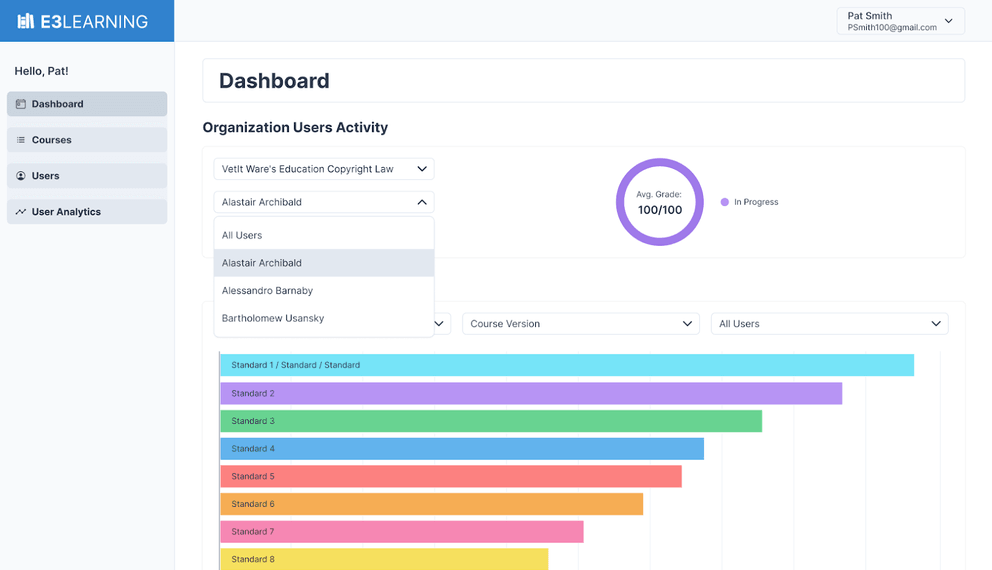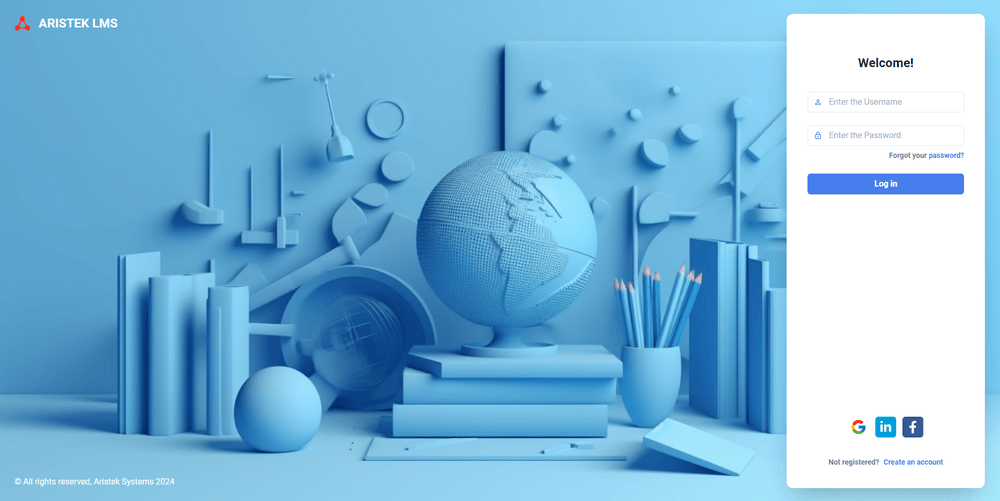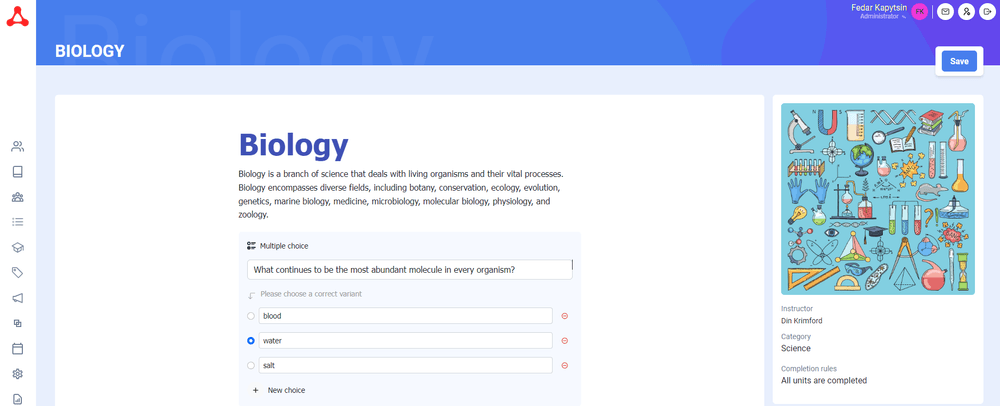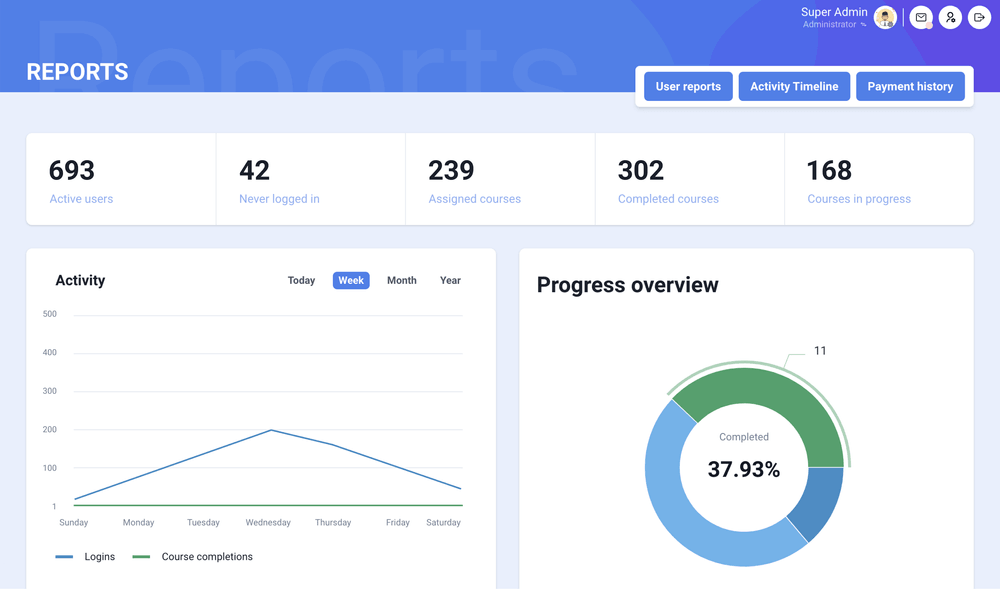Are you happy with your LMS? Sometimes the software is great, but it misses just one important component. Turns out, you can improve your LMS.
Today we are talking about LMS integration. This article is mostly about corporate LMS, but we also have one about LMS integrations in K-12. Let’s get going.
What is an LMS Integration
Think of integrations as the bridges that link your LMS to external tools. Without them, your LMS is just a learning platform. It’s a place where teachers can create courses for learners to pass.
With integrations, you can add features from other apps into your LMS or simply move data around. Imagine logging into your LMS directly from your Facebook account or editing a Google Doc right out of the LMS interface
Let’s say, you want to integrate Zoom lectures. Even without integrations, you can still paste a Zoom call link to your LMS. Then, users would follow the link, leave your LMS, log into Zoom, and get on with the lecture. With the Zoom integration, the calls will be within your LMS. This means no need for additional logins, and the calls can get scheduled automatically, based on the LMS course calendar.
How do LMS integrations work
Technology-wise, there are 5 main ways to integrate LMS: with API, SSO, file transfers, webhooks, and middleware software. Here’s how they work.

SSO
SSO (single sign-on) is a way to log into other applications with a click of a button, without entering the password.
Think of accessing your LMS with a Google account. Instead of asking for your password, the LMS can ask Google if you’re logged in there. If you are, the LMS will let you in.
There are plenty of SSO standards: OAuth 1 & 2, OpenID Connect, SAML, LDAP, and more. You don’t have to go too deep in there, but just realize that there are many different technologies for SSO.
API
API (application programming interface) is the main way for LMS integration. API is a set of rules that regulate how external applications can communicate.
A regular application only works with its own data, it ignores the outer world. But if the app supports API, it can start processing data from other systems.
APIs work back and forth. Your LMS requests something from another service, and that service will decide whether to send the information back. In other words, your LMS pulls data via API.
So they are perfect for sending data that constantly gets updated. Basically, when you want to have an app within another app, API is the way to go.
Webhooks
Webhooks are like API, but backwards: while APIs pull data, webhooks push it. When some event triggers a webhook (a user logs in or payment is received), the app sends the data to the LMS. Because the LMS doesn’t request data, webhooks are “backwards APIs”.
Their advantage is that webhooks work in real-time, as they don’t need the approval of the other app to send data. But is also a disadvantage, because webhooks can only send data one way, while API allows for communication in both directions.
That’s why webhooks are great for managing large volumes of data in real-time. They are perfect for sending notifications, integrating an analytics service, or triggering event-based actions – like automatically registering new users or creating courses.
Middleware
Middleware is an intermediary software between your LMS and the other service.
When your LMS doesn’t support many integrations, you can integrate with middleware. And that middleware will get you integrations will all sorts of apps.
Let’s say you want to integrate with Zoom, PayPal, and Dropbox but your LMS doesn’t support the integrations. What you can do is to integrate a middleware app, and that app will integrate with everything you need.
One example of middleware software is Aristek Integration. It’s a customizable LMS that integrates with a ton of services. We create a custom integration between your LMS and Aristek Integration, and from there, you get to integrate with 3rd party LMS, SIS, and other apps. This is especially useful in K-12 education.
File transfer
File transfer simply means moving files between applications.
This could be course files like SCORM or Common Cartridge. When you’re migrating from an older LMS, you need to move the courses, too. File transfer is usually the last hope. If both LMS support file transfer, you can download the files from one LMS and upload them to another. Without file transfer support, you may have to recreate all the courses manually.
But it applies to any other files: videos, presentations, sheets, and so on. It’s nice to be able to export files.
What are the perks of LMS integration
- More features. That’s the most obvious one. If your LMS lacks a feature, just integrate another application to take care of it.
- Everything is in one place. Who wants to keep credentials to 5 different apps?
- Fewer boring tasks. No need to manually pass files around, better make the LMS to do it for you.
- Better analytics. Computers extract and analyze more data than a person ever could. Especially, if you integrate with a powerful BI tool.
Here’s just one example. Think of Archibald from HR, whose job is to manage employee training. Before LMS integrations, he had this routine:
- First, he needed to collect data. If he’s lucky, the LMS could export an Excel spreadsheet with all the grades and answers. If not, well, he’d have to copy it all by hand.
- Then he’d do a lot of data processing. Like creating reports about a few hundred people.
- He’d analyze the reports. Either personally, or via a BI tool.
When the company integrated the LMS with a couple of tools, data reports became automated. Archibald could get a break from passing data around and move to interesting tasks. But LMS integration is not only about data engineering, let’s see what else it brings to the table.
Real-life example
We built a tool that integrates educational software. It connects your K-12 LMS with all sorts of eLearning tools, from other LMS to SIS.

What can you integrate with LMS
Remember, this article is about corporate LMS, so we’ll mostly discuss integrations that a business may need. Feel free to check out our K-12 integration guide, as well.
SSO integration
Examples: Google, Facebook, Okta.
SSO (Single Sign On) helps you log in with a click of a button instead of entering credentials. We’ve already discussed SSO, but it’s worth mentioning again because it’s both a technical method and a type of integration.
SSO is not just about convenience for users. It also simplifies the administrator’s job, because SSO centralizes user management. Finally, it improves security – the fewer breach options there are, the better.

HR software integration
Examples: Workday, SAP SuccessFactors, BambooHR.
Tools like Human Resource Management Systems (HRMS) optimize the workflow for your HR department. This is the place to manage employee data, payroll, benefits, or recruitment.
An LMS integration will sync employee data between two systems. So when a new employee joins the company, they’ll automatically get an LMS account with the specific onboarding courses already set up. The LMS will also pass performance results back to the HRMS.
This way, it becomes easy to assess employee performance.
CRM integration
Examples: Salesforce, HubSpot, Microsoft Dynamics.
CRM helps companies manage their customers. It keeps customer data, sales activities, and marketing efforts.
It goes both ways, you can teach both your customers and employees.
When you sell online courses or complicated solutions, the integration is a must have. You can centralize your sales from different channels in the CRM, and automatically grant course access to the clients.
You can also train the sales department. A sales rep will get product information, sales scripts, and objection handling guides right from the CRM.
ERP integration
Examples: SAP, Oracle ERP Cloud, Microsoft Dynamics 365.
Enterprise Resource Planning is the backbone of organizations dealing with physical goods. It’s a centralized platform that handles inventory management, tracking transactions, and operations.
An LMS integration with the ERP ensures that training aligns with your global goals and activities. When a new employee joins the company, their details are automatically synced between the ERP and LMS, so they’re ready to start learning right away. Plus, by linking training outcomes directly to business performance metrics, the integration will give insights into how learning contributes to overall performance.
LRS integration
Examples: Watershed, Learning Locker, Yet Analytics
A Learning Record Store (LRS) stores learning data. So while LMS is the place to learn, LRS is a database that stores learner interactions with that content, the grades, and overall performance.
The integration will help you get a full picture of the learners. You’ll improve analytics and reporting about the learners. You’ll track course completion rates and locate content that needs improvement
Corporate chat integration
Examples: Slack, Teams, Google Chat
Chances are, your company already has a chat. So does it make sense to keep another chat just for the learning? Oftentimes, LMS chats are simply ignored. When all the information is in one place, it’s easier to navigate.
Video conferencing & virtual classrooms
Examples: Zoom, Google Meet, Microsoft Teams
Most LMS don’t have a built-in virtual classroom. Sometimes there is one, but it’s not the one you need. Just like with chats, your company probably has an app for online calls. Why not use it for your virtual classrooms?
When you keep all the calls and lectures on one platform, it’s so much easier to manage them. Let’s say, you had an interesting meeting with a client and learned many insights. Turn that call recording into a lecture and import it into the LMS, so your colleagues can easily locate it later.
Authoring tools integration
Examples: Articulate 360, Adobe Captivate, iSpring Suite
Most LMS already have a built-in course creator. But sometimes it’s just too weak: it wouldn’t support videos or the assessments won’t support multi answers.
If you’re happy with the rest of LMS, there’s no need to upgrade the entire system. Maybe a simple integration will do.

Performance tracking integration
Examples: Workday Performance, SAP SuccessFactors, Oracle HCM Cloud.
Performance tracking software comes in two ways. Some is focused on time tracking. Others help employees get ready for performance reviews and set goals. It usually includes tools for feedback and development planning.
With an LMS integration data from both tools is synched. Grades and achievements from the LMS are automatically moved into the performance tracker. This aligns employee goals with their performance, so managers can evaluate employees with data.
Certification platforms integration
Examples: Accredible, Credly, DigitalChalk.
Certification platforms make it easy to manage professional certifications and badges. They help track your employee skills and achievements.
If your LMS can issue certificates, it’s possible to integrate an external tool. Then, learners will automatically get their certifications after finishing courses. Most certification platforms are customizable, too. With these integrations, so you can handle compliance and track employee accolades.
Analytics & BI tools integration
Examples: Tableau, Power BI, and Google Analytics.
These tools visualize data in interactive dashboards and reports. They help analyze your business, from sales to marketing and operations.
Your LMS stores progress about employee training but it doesn’t know anything about the company. Business intelligence solutions work the other way – with BI tools learning content can pull up company data. So your marketing team will always have fresh data in the LMS course.

Payments & subscriptions integration
Examples: PayPal, Stripe, Square.
If you sell courses online, you’ll need a way to accept payments. Services like Stripe will handle online transactions. They offer features for processing payments, managing invoices, and taking care of subscriptions.
When learners purchase a course, the integration will ensure seamless enrollment and access to the content upon payment confirmation. A good integration will also automatically manage course access based on payment status.
Document management (DMS) integration
Examples: SharePoint, Dropbox Business, Google Workspace.
Document Management Systems streamline document access and organization. They serve as a centralized hub for keeping and sharing documents across teams.
An LMS integration with a DMS ensures seamless access to training materials. It allows for the easy import of documents. Policies, manuals, or training materials can go directly into the LMS. It also ensues that employees have the resources they need to complete their training effectively.
How to integrate my LMS?
Check of the LMS supports integrations
If you have a SaaS LMS, check the developers’s website. Most companies have a specific page for integrations.
When you have a custom LMS, check integration options with your developer – or reach out to us for help.
Integrate learning apps with LTI
Here’s a little lifehack. Even if the LMS developer doesn’t mention a specific integration, there’s a good chance you can still integrate. There is just too much software out there to list all possible integrations.
There’s a standard for LMS integration called LTI. If both your LMS and the third-party tool support the same LTI version, the integration is easy. If the applications support different LTI versions, it gets more complicated – but still possible to integrate.
The only hiccup is that most of the software that supports LTI is educational. So you won’t integrate PayPal with it. Still, check out LTI compatibility on the official website, there are currently 320 supported applications.

Nothing works! How do I integrate?
We can help. We’ll integrate your LMS via APIs, webhooks, or otherwise. We even built an LMS integration platform that will help you integrate fast. Get a free consultation. to learn more.




